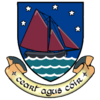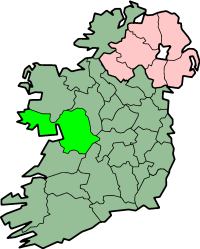County Galway
| County Galway Contae na Gaillimhe |
||
 |
||
|---|---|---|
| Location | ||
|
||
| Statistics | ||
| Province: | Connacht | |
| County seat: | Galway | |
| Code: | G (GY proposed) | |
| Area: | 6,148 km2 (2,374 sq mi) | |
|
Population (2006) |
231,035(including Galway City); 159,052 (without Galway City) | |
| Website: www.galway.ie | ||
County Galway (Irish: Contae na Gaillimhe) is located on the west coast of Ireland. It is in the Irish province of Connacht. The county takes its name from the city of Galway. It is the second largest county in Ireland, after County Cork. There are several strongly Irish-speaking areas in the west of the county.
Contents |
History
The county comprises a number of distinct territories which predate the formation of the county by the English colonial administration in Ireland in the late 1500s. The major ones are Iar Connacht, or 'West Connacht', which covers the portion of the county (and also a small part of County Mayo) west of Loch Corrib and which contains Connemara in the far west and Joyce Country in the north-west. The territory of Aidhne lies in the south of the county and is coextensive with the diocese of Kilmacduagh.
The territory of what was once known as Uí Maine or Tír Maine covers most of the east of the county but also covers south County Roscommon. Maigh Seola covers the portion of the county along the eastern side of Lough Corrib. A number of inhabited islands are administered by the county; they include Oileáin Árann (Aran Islands) and Inis Bó Fine (Inishbofin).
The first inhabitants in the Galway area arrived over 7000 years ago. Shell middens tell us about the existence of people as early as 5000 BC.
With the arrival of Christianity many monasteries were built.
Geography
County Galway is home to Lough Corrib (the largest lake in the Republic of Ireland) the Na Beanna Beola (Twelve Bens) mountain range, Na Sléibhte Mhám Toirc (the Maum Turk mountains), and the low mountains of Sliabh Echtghe (Slieve Aughty).
The highest point in the county is one of the Twelve Bens, Benbaun, at 729m.
Towns and villages
- Ahascragh, Ardrahan, Athenry, Aughrim
- Ballinasloe, Ballinderreen, Ballyconneely, Ballygar, Ballymoe, Ballynahinch, Barna, Bealadangan, Bullaun,

- Camus, Carnmore, Carraroe, Casla, Castlegar, Claregalway, Clarinbridge, Cleggan, Clifden, Clonbur, Corofin, Corrandulla, Corr na Móna, Craughwell
- Dunmore
- Furbo
- Glenamaddy, Gort
- Headford, Hollygrove
- Inverin
- Kilcolgan, Kilconnell, Kilkerrin, Kilkieran, Killimor, Kilronan, Kiltullagh, Kinvara
- Laurencetown, Lebane, Leenaun, Lettercallow, Letterfrack, Lettermore, Loughrea
- Maam Cross, Maum, Monivea, Mountbellew, Moycullen, Muckanaghederdauhaulia
- Newbridge, New Inn
- Oranmore, Oughterard
- Peterswell, Portumna
- Recess, Rosmuck, Rossaveal, Roundstone
- Spiddal
- Tuam, Turloughmore
- Williamstown, Woodford
Climate
The location of County Galway, situated on the west coast of Ireland, allows it to be directly influenced by the Gulf-Stream. Temperature extremes are rare and short lived, though inland areas, particularly east of the Corrib, can boast some of the highest recorded temperatures of the summer in the island of Ireland (sometimes exceeding 30 °C); though these temperatures only occur when land warmed east winds sweep the area; the opposite effect can occur in the winter. Overall, however, Galway is influenced mainly by Atlantic airstreams which bring ample rainfall in between the fleeting sunshine. Rainfall occurs in every month of the year, though the late autumn and winter months can be particularly wet as Atlantic cyclonic activity increases and passes over and around the area, and which is why Galway tends to bear the brunt of severe windstorms that can occur between August and March. The county on average receives about 1300mm of rainfall annually, though some areas along the west coast of the county can receive up to 1900mm and beyond. Extreme weather such as blizzards, thunderstorms, flashflooding and hail, though rare, can and do occur, particularly when air masses of continental origin are undercut by more humid and unstable Atlantic flows.
Fauna and Flora
One of the least densely populated counties, County Galway harbors a variety of wildlife. The regions biodiversity is best represented by Connemara National Park situated in the west of the county.
Flora
T. Johnson reported a visit to Roundstone in 1893 (?) Johnson.[1]
Demographics
The population of the county at the April 2006 census was 159,052 (Figure does not include that of Galway City as it is a separate administrative unit).
Galway Septs
Galway was the home to many powerful Irish septs. Common surnames include Clark, Connolly, Coyne, Curley, Egan, Ford, Hession (O'hOisin), Joyce, Kelly, Lohan, Lydon, Madden, Manion, O'Connor, O'Flaherty, O'Shaughnessy, and Tierney. In addition, many notable Norman-Irish families can be found in Galway, such as Barrett, Birmingham, Browne, Burke, Lynch, Skerrett, Stanton and Staunton.
Politics
European elections
County Galway is part of the North-West constituency for the purposes of European elections.
National Elections (for Dáil Éireann)
County Galway is divided into two electoral constituencies for the purposes of electing TDs to Dáil Eireann during general elections. These are:
- Galway East, Electorate: 73659, Example towns: Ballinasloe, Tuam, Loughrea.
- Galway West, Electorate: 82213, Example towns: Galway City, Clifden.
Local Elections
Many smaller constituencies exist for the purposes of local elections.
References
- ↑ Johnson, T. 1893. A visit to Roundstone, Co. Galway. Ir. Nat.2:313 - 316.
See also
- Connacht Irish
- Galway East (Dáil Éireann constituency)
- Galway West (Dáil Éireann constituency)
- Galway GAA
- List of abbeys and priories in the Republic of Ireland (County Galway)
External links
- Galway County Council
- Tourist information website
- Map of Galway
- *FLIRT FM* Galways Student Radio Station NUIG/GMIT
- Galway GAA
- / local newspaper
- Extensive list of places in County Galway.
|
||||||||||||||||||||

